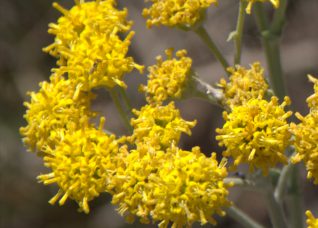
MinerAlert

MinerAlert
Cota tinctoria
Asteraceae
Indian tea, Hopi Tea, Navajo Tea, Zuni Tea, Colorado Greenthread
Cota, Hierba de San Nicolás, Té Silvestre, Té de los Navajos, Té de Cota (White, 2003).

The genus Thelesperma is native to North America, although certain species are also found in South America. Cota is a perennial plant that is found in various areas of United Sates including Arizona, Colorado, Kansas, Nebraska, New Mexico, Oklahoma, Texas, Utah, and Wyoming. In Northern Mexico, the plant is found in the states of Chihuahua and Coahuila (Allred 2011; Kane, 2009; Moore, 1979).
The whole plant.
Many years ago, before tea or coffee were consumed in the state of New Mexico, Cota was a very popular beverage, both for it pleasant sweet piney taste, as well as for medicinal purposes (Moore, 1979; Curtin, 1965). A decoction is made by boiling the plant in water for approximately five minutes and can be taken hot or cold and sweetened with sugar or honey. A tea is available in commerce and sold as Cota, Greenthread, or Indian Tea. Sometimes Cota is combined with other plants such a cinnamon , spearmint, and pennyroyal to make a tastier tea (Moore, 1990).
The plant is taken as a tea to relieve stomachaches and other digestive ailments. It is also used to reduce fevers, to treat kidney problems, to “purify the blood”, against gonorrhea, as a vermifuge (to expel intestinal worms), as a stimulant for the nervous system, and applied as a mouthwash to reduce tooth pain. The decoction of the plant can also be applied externally as a wash or poultice in order to relieve chafing and other skin ailments in babies. The plant is also an important source of natural dyes for basket weaving and textiles (Kane, 2009; Moore; 1979; Curtin, 1965). However, there are no known clinical trials to ascertain its effectiveness.
One of the main active ingredients in Cota is known as luteolin. Duke (1992) ascribes a wide array of medicinal effects to this compound which include anti-cancer, anti-cataract, anti-inflammatory , antioxidant , antispasmodic, antitussive (against coughs), antiviral, choleretic (improves gall bladder function), diuretic, and hepatoptrotective (liver protective), among others.
Safety/Precautions:
Before you decide to take any medicinal herb or herbal supplement, be sure to consult with your health care professional first. Avoid self-diagnosis and self-medication: Always be on the safe side!